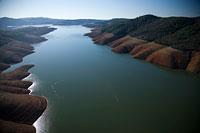What are the Challenges?
The San Francisco Bay Delta Watershed is facing a number of significant environmental and economic challenges. Population growth, increasing water demand, loss of habitat and water pollution continue to present difficulties in planning for the watershed’s future.
The watershed contains one of the world's largest water supply systems, the federal Central Valley Project Exit and the State Water Project Exit These water projects have approximately 16.8 million acre-feet of combined water storage capacity and deliver a combined average of 10 million acre-feet per year for irrigation, industrial, and municipal users.

- Current Challenges in the Bay and Delta
- Impaired Water Quality in the Watershed
- Impacts of Climate Change
Current Challenges in the Bay and Delta
Throughout the San Francisco Bay, state Water Quality Standards are exceeded for pesticides, invasive species, mercury and other metals and toxic substances. Many miles of beaches are impaired for unacceptable levels of bacteria due to sewage spills and crumbling sewage infrastructure. Habitat destruction has eliminated more than 90 percent of shoreline wetlands and 40 percent of the total San Francisco Bay aquatic ecosystem in the last 150 years, leading to the special protection of more than 90 species of plants and animals.
The Bay Delta Watershed is confronted by a wide range of challenges that are magnified and concentrated in the Sacramento-San Joaquin River Delta, the heart of California's water system. Decades of pollution and water exports have led to sharp declines in Bay Delta fish contributing to the collapse of California's salmon fishing industry.
Occasional droughts reduce water supply for agriculture and cities, contributing to difficult economic conditions. Aging levees around sub-sea level Delta islands leave homes, communities, farms, transportation corridors, and energy infrastructure vulnerable to sea level rise, levee collapse, and flooding. A major earthquake would cause a catastrophic failure of the levee system, jeopardizing lives, cities, and water supplies from the Delta to San Diego.
Impaired Water Quality in the Watershed
Poor water quality in the Watershed and its tributaries affects terrestrial and aquatic ecosystems, drinking water, recreation, industry, agriculture, and the local and state economy. The California Water Resources Control Board collects data on contaminants that degrade water quality to generate its list of impaired waterbodies. (CWA Section 303(d) list). Exit
Some pesticides and metals are legacy problems, such as the banned organochlorine pesticide DDT and mercury from abandoned mines. Most contaminants contributing to poor water quality are the result of current-use compounds from industrial, agricultural, urban, transportation, and natural sources. In addition, there is growing concern about new classes of contaminants, such as pyrethroid pesticides, pharmaceuticals and personal care products.
In addition, California issues health advisories to warn the public about eating fish with unsafe levels of contaminants from certain waterways.
Impacts of Climate Change

Lake OrovillePotential climate change impacts to the San Francisco Bay Delta Watershed include more extreme weather, shifting precipitation patterns resulting in reduced snowpack, flooding, enduring drought and low water flows, as well as endangered species habitat loss and rising sea levels in the San Francisco Bay and Delta.
EPA supports planning to protect our water resources from damage and loss that could result from climate change. EPA and the state of California recently published a Climate Change Handbook for Regional Water Planning Exit which provides a framework for considering climate change in water management planning.
As part of our Climate Ready Estuaries Program, EPA also published a technical report exploring a new way to measure vulnerability to climate impacts using San Francisco Bay's salt marsh and mudflat ecosystem as a demonstration. More information about responding to the impacts of Climate Change in the watershed can be found in EPA's Draft National Water Program Strategy and in the EPA Climate Change and Water website.
EPA's Climate Ready Water Utilities initiative provides resources for the water sector to adapt to climate change by promoting a clear understanding of climate science and adaptation options, and by promoting integrated water resources management planning. Our Climate Change website also provides information about other EPA assistance available to help with planning for climate change.
